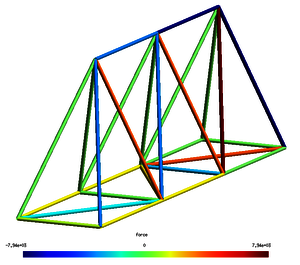4RA00 - Mechanics
Contents
After a 3-D extension of the concept of equilibrium, that belongs to secondary school knowledge, and the introduction of the notions of strain and stress a couple of simple statically determinate structures are discussed. These are problems that can be solved by pure application of the equilibrium equations. Subsequently this knowledge is applied to statically determinate pin-jointed structures and thin-walled pressurized cylinders and spheres. Furthermore, an alternative, but faster, method for analyzing statically determined structures is introduced: the method of virtual work. In order to be able to solve statically indeterminate problems, first the constitutive behavior (the relation between deformation and stresses) must be known. For that purpose the simplest linear elastic behavior is introduced. Hereafter we are able to analyze both statically determined and undetermined structures. The basics of a computer-oriented solution method, The Finite Element Method (FEM), are made plausible for this kind of problems. This is sufficient to follow a training course in the FEM-package MARC/MENTAT. Three-axial deformation and stress-states in pressurized thin-walled vessels are dealt with. Attention is given to deformations and stresses caused by thermal expansion. An important part of the course is captured by the theory of simple beams. The following subject are brought up:
- the assumptions of the theory;
- different types of support and their influence;
- different types of loading, bending moments, shear forces and distributed loads;
- the influence of the shape of the cross-section;
- the resulting normal- and shear-stresses in the cross-sections of the beam;
- deformation, sagging and rotation of the beam due to the load;
- strengthened and compound beams;
- and the use of software for the analysis of beam-problems.
Simple formulas are derived for the relation between deformations and loads for a limited number of cases, beams with abound kinematical and dynamic boundary-conditions. These formulas can than easily be used for more complicated cases by using them in a special manner. They can also be used as simple hand-controls using advanced software. Subsequently torsion problems for simple cylindrical shafts with a circular cross-section are handled. This is the simplest case of torsion with a relatively simple theory for the description of the deformation and the stress-states. Apart from the strength and the stiffness some attention is given to the stability of constructions. A construction is instable if, after exceeding a characteristic load, a small increase in load causes a large change in deformation. The phenomenon of instability is clarified for the simplest cases of buckling struts and columns. This subject is very different from the former subjects because the equilibrium in the deformed state is studied, and so the phenomenon of geometric non-linearity is introduced.
Learning objectives
Learning the skills to analyze the thermo-mechanical behavior of simple (quasi-)static constructions under certain load conditions, namely in the design stage, through a mathematical modeling thereof, constantly being conscious of the limitations of the learned methods.
